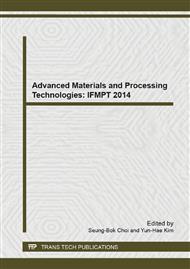[1]
Batzill M, Katsiev K, James M, et al. Gas-phase-dependent properties of SnO2 (110), (100), and (101) single-crystal surfaces: Structure, composition, and electronic properties [J]. Physical ReviewB, 2005, 72: 165414- 20.
DOI: 10.1103/physrevb.72.165414
Google Scholar
[2]
M. Bataill, U. Diebold, Prog. Surf. Sci. 79(2005) 47.
Google Scholar
[3]
Chun-Mei Liu, Xiang-Rong Chen, Guang-Fu Ji. First-principles investigations on structural, elastic and electronic properties[J]. Computational Materials Science. 50(2011) 1571-1577.
DOI: 10.1016/j.commatsci.2010.12.018
Google Scholar
[4]
Y. He, J.F. Liu, W. Chen, et al. Phys. Rev. B 72 (2005) 212102.
Google Scholar
[5]
S.R. Shieh, A. Kubo, T.S. Duffy, et al. Phys. Rev. B 73 (2006)014105.
Google Scholar
[6]
J.L. Jacquemin, C. Alibert, G. Bordure, Solid State Commun. 12 (1972) 1295.
Google Scholar
[7]
P. Barbara, S.F. Matar, Comput. Mater. Sci. 10 (1998) 368.
Google Scholar
[8]
M. Meyer, G. Onida, A. Ponchel, L. Reining, Comput. Mater. Sci. 10 (1998) 319–324.
Google Scholar
[9]
L.A. Errico, Physica B 389 (2007) 140.
Google Scholar
[10]
G. Rahman, V.M. García-Suárez, S.C. Hong, Phys. Rev. B 78 (2008) 184404.
Google Scholar
[11]
Y. Li, W. Fan, H. Sun, X. Cheng, P. Li, X. Zhao, J. Hao, M. Jiang, J. Phys. Chem. A 114 (2010) 1052.
Google Scholar
[12]
Q.J. Liu, Z.T. Liu, L.P. Feng, Comput. Mater. Sci. 47 (2010) 1016.
Google Scholar
[13]
V. Milman, B. Winkler, J.A. White, C.J. Packard, M.C. Payne, E.V. Akhmatskaya, R.H. Nobes, Int. J. Quantum Chem. 77 (2000) 895.
Google Scholar
[14]
M.C. Payne, M.P. Teter, D.C. Allen, T.A. Arias, J.D. Joannopoulos, Rev. Mod. Phys. 64 (1992) 1045.
Google Scholar
[15]
J.P. Perdew, K. Burke, M. Ernzerhof, Phys. Rev. Lett. 77 (1996) 3865.
Google Scholar
[16]
S.H. Vosko, L. Wilk, M. Nusair, Can. J. Phys. 58 (1980) 1200.
Google Scholar
[17]
A. Bouhemadou, Braz. J. Phys. 40 ( 2010) 52.
Google Scholar
[18]
Hettenbach MS, Weiss T, Barsan N, et al. STM, LEED and Photoemission Studies of SnO2(110)Surface and SnO2 Gas Sensors[J]. International Seminar on Semiconductor Gas Sensors, Ustron(PL), 2000, 37: 1- 5.
Google Scholar
[19]
Rahman G, Victor M, Garcia S. Surface- induced magnetism in C-doped SnO2 [J]. Applied Physics Letters, 2010, 96: 052508- 9.
DOI: 10.1063/1.3302468
Google Scholar
[20]
P.D. Borges, L.M.R. Scolfaro, H.W.L. Alves, and E.F. da Silva Jr. Theor. Chem. Acc. 126(2010)39.
Google Scholar


